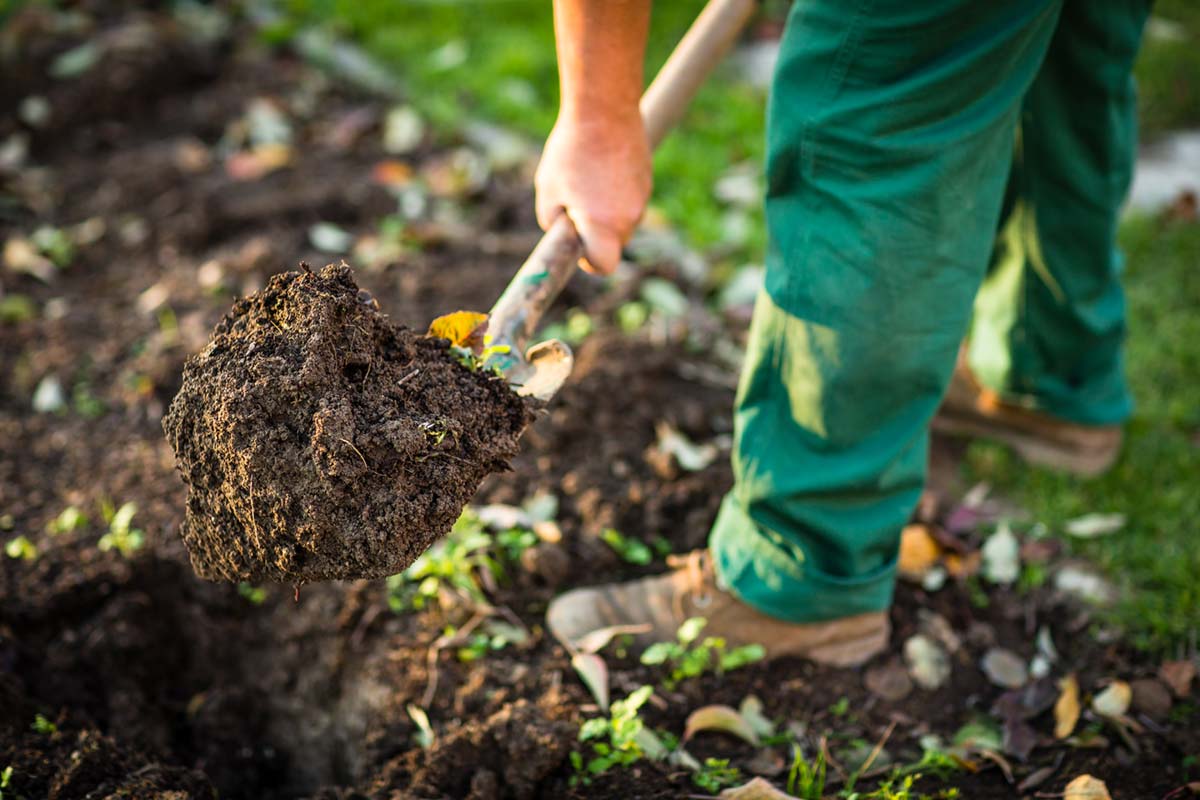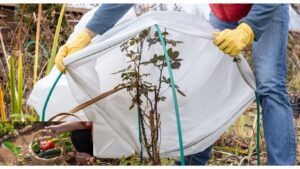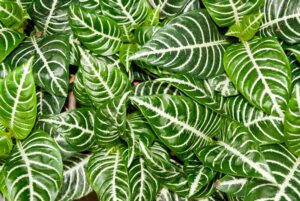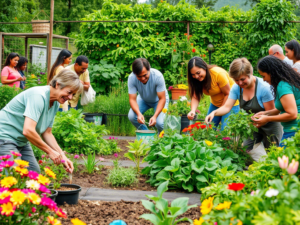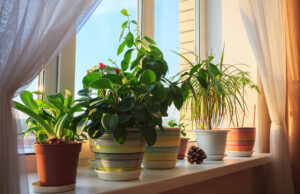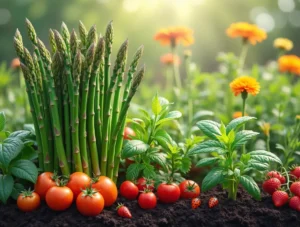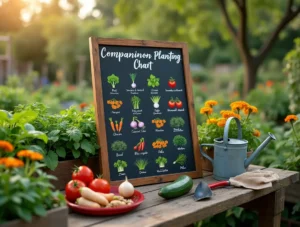Choosing the right plants is a crucial step in growing an organic garden. Not all plants are created equal when it comes to organic gardening, and selecting the right varieties can make a big difference in your garden’s success.
Choosing Organic Seeds and Seedlings
Starting with organic seeds or seedlings ensures that your plants are free from synthetic chemicals right from the beginning. Here’s what you need to know about choosing the best options:
- Benefits of Using Organic Seeds: Organic seeds are harvested from plants that have been grown without synthetic fertilizers, pesticides, or genetically modified organisms (GMOs). These seeds are often more resilient, having been bred to thrive in natural conditions without chemical intervention. This resilience can translate into stronger plants that are better able to withstand pests and diseases.
- Where to Buy Organic Seeds: You can find organic seeds at most garden centers, but for a wider variety, consider purchasing from specialized online retailers. Some reputable sources for organic seeds include Johnny’s Selected Seeds, Baker Creek Heirloom Seeds, and Seed Savers Exchange. These companies offer a vast selection of organic and heirloom seeds, allowing you to grow unique and hard-to-find varieties.
- Selecting Seedlings from Reputable Sources: If you prefer to start with seedlings rather than seeds, make sure you buy them from reputable organic nurseries. Look for seedlings that are certified organic, as this ensures they were grown without synthetic chemicals. When selecting seedlings, choose healthy, vigorous plants with no signs of pests or disease.
Best Plants for Beginners
If you’re new to organic gardening, starting with easy-to-grow plants can boost your confidence and ensure a successful first season. Here are some great options:
- Leafy Greens (e.g., Lettuce, Spinach, Kale): These cool-season crops are quick to mature and don’t require much space. They thrive in partial shade and can be harvested multiple times throughout the growing season.
- Tomatoes: Tomatoes are a favorite in many gardens and for good reason. They are relatively easy to grow, especially in warm climates, and offer a high yield. Opt for disease-resistant varieties to minimize issues like blight.
- Herbs (e.g., Basil, Parsley, Cilantro): Herbs are low-maintenance and can be grown in pots or directly in the ground. They are perfect for small spaces and can add flavor to your cooking while also attracting beneficial insects to your garden.
- Zucchini and Squash: These prolific plants are known for their abundant harvests. They grow well in most climates and can be used in a variety of dishes.
Companion Planting: Maximizing Your Garden’s Potential
Companion planting is an ancient gardening technique that involves growing certain plants together to enhance growth, deter pests, and improve yields. Here’s how to use it effectively:
- Benefits of Companion Planting: Some plants have natural properties that can help others thrive. For example, marigolds release chemicals into the soil that can deter nematodes, which are harmful to the roots of many vegetables. Similarly, basil planted near tomatoes can improve their flavor and growth while repelling insects like mosquitoes and flies.
- Common Companion Plant Pairings:
- Tomatoes and Basil: As mentioned, basil enhances the flavor of tomatoes and repels pests.
- Carrots and Onions: Onions help deter carrot flies, a common pest of carrots.
- Cabbage and Dill: Dill attracts beneficial insects that prey on cabbage pests like aphids and caterpillars.
- Plants to Avoid Planting Together: While some plants are great companions, others can inhibit each other’s growth. For example, avoid planting beans near onions or garlic, as they can stunt each other’s growth. Similarly, fennel is notorious for being a poor companion to most garden plants, as it releases chemicals that can inhibit growth.
Heirloom vs. Hybrid Plants: What’s Best for Your Organic Garden?
Understanding the difference between heirloom and hybrid plants can help you make better choices for your organic garden.
- Heirloom Plants: These are traditional varieties that have been passed down through generations. They are open-pollinated, meaning they rely on natural pollination methods (like wind or insects) and their seeds can be saved and replanted each year. Heirloom plants are prized for their flavor, diversity, and ability to adapt to local growing conditions.
- Hybrid Plants: Hybrids are the result of controlled cross-pollination between two different plant varieties to produce offspring with specific traits, such as disease resistance or improved yield. While hybrids can offer benefits like increased vigor and uniformity, their seeds do not produce true-to-type plants if saved and replanted.
- Which Is Better?: For organic gardening, many purists prefer heirloom varieties because they are more likely to have been grown without chemicals and are better adapted to natural growing conditions. However, hybrids can also be a good choice, especially for beginners who may benefit from their disease resistance and reliable performance.
Growing Perennial vs. Annual Plants
Deciding between perennials and annuals is another important consideration when planning your organic garden.
- Perennials: These plants live for more than two years, coming back each season after going dormant in the winter. Perennials like asparagus, rhubarb, and many herbs can be a great investment because they require less replanting and maintenance over time. They also help establish a more permanent garden structure.
- Annuals: Annual plants complete their life cycle in one growing season, meaning they must be replanted each year. Common garden vegetables like tomatoes, peppers, and lettuce are annuals. While they require more regular planting, they also offer the flexibility to change your garden layout and try new varieties each year.
- Mixing Perennials and Annuals: For a balanced garden, consider mixing perennials and annuals. Perennials can provide a reliable backbone to your garden, while annuals add diversity and allow you to experiment with different crops each season.
Soil Preparation: The Foundation of a Thriving Organic Garden
Healthy soil is the cornerstone of any successful garden, and it’s especially critical in organic gardening. By nurturing your soil, you’re creating an environment where plants can grow strong, resist pests, and produce bountiful harvests.
Understanding Soil Types
The first step in soil preparation is understanding what type of soil you have. Different soils have different properties, and knowing your soil type can help you amend it properly for optimal plant growth.
- Sandy Soil: Sandy soil is light and drains quickly, which can be both a blessing and a curse. While it’s easy to work with, it doesn’t hold nutrients well, meaning you may need to amend it frequently with organic matter like compost to improve fertility.
- Clay Soil: Clay soil is dense and heavy, making it difficult for roots to penetrate and water to drain. However, it’s rich in nutrients. The key to working with clay soil is to improve its structure by adding organic matter to increase aeration and drainage.
- Loamy Soil: Loamy soil is often considered the ideal garden soil. It’s a balanced mix of sand, silt, and clay, providing good drainage, moisture retention, and fertility. If you have loamy soil, you’re off to a great start, but regular additions of compost can keep it in top condition.
- Testing Your Soil: You can determine your soil type by doing a simple soil test. Squeeze a handful of moist soil in your hand and observe its texture:
- Sandy soil feels gritty and crumbles easily.
- Clay soil feels sticky and forms a firm ball.
- Loamy soil feels smooth and holds together in a loose, crumbly ball.
Soil pH: Balancing Acidity and Alkalinity
Soil pH is a measure of how acidic or alkaline your soil is, and it can greatly affect plant growth. Most vegetables prefer a slightly acidic to neutral pH (around 6.0 to 7.0).
- Testing Soil pH: You can test your soil’s pH with a home testing kit, which is available at most garden centers, or by sending a sample to a local extension service for a more detailed analysis. Knowing your soil’s pH can help you decide whether you need to make adjustments.
- Adjusting Soil pH:
- To Raise pH (Make More Alkaline): Add lime (calcium carbonate) to the soil. It’s best applied in the fall to allow time to break down before spring planting.
- To Lower pH (Make More Acidic): Add sulfur or organic materials like pine needles, peat moss, or composted leaves. This process can take time, so start well before planting.
Improving Soil Fertility with Organic Matter
One of the most important aspects of soil preparation is ensuring it has enough organic matter, which improves soil structure, nutrient content, and moisture retention.
- Composting: Compost is the best way to add organic matter to your soil. It’s rich in nutrients and beneficial microorganisms that help plants grow. You can create compost at home by recycling kitchen scraps, yard waste, and other organic materials. Ensure your compost is fully decomposed before using it, as fresh compost can burn plant roots.
- Manure: Well-rotted manure is another excellent soil amendment. It adds organic matter and nutrients, particularly nitrogen, which is essential for plant growth. Use manure from herbivores like cows, horses, or chickens, and make sure it’s well-aged to avoid burning plants with too much nitrogen.
- Cover Crops: Planting cover crops, also known as green manure, is a way to add organic matter to your soil between growing seasons. Crops like clover, rye, or buckwheat can be grown and then tilled into the soil, enriching it with nutrients and improving structure.
Mulching: Protecting and Nourishing Your Soil
Mulching is a critical practice in organic gardening. It helps conserve moisture, suppress weeds, and regulate soil temperature.
- Types of Mulch:
- Organic Mulches: These include materials like straw, leaves, grass clippings, or wood chips. As they break down, they add organic matter to the soil.
- Inorganic Mulches: These include materials like black plastic or landscape fabric. While they don’t add nutrients, they’re effective at suppressing weeds and retaining moisture.
- Applying Mulch: Apply a layer of mulch 2-4 inches deep around your plants, taking care not to pile it directly against stems or trunks, which can lead to rot. Mulch should be replenished as it breaks down, particularly in vegetable gardens where organic mulches are preferred.
Creating Healthy Soil: A Continuous Process
Maintaining healthy soil isn’t a one-time task; it’s an ongoing process. Regularly testing your soil, adding organic matter, and adjusting pH as needed will keep your soil in peak condition, providing a strong foundation for your organic garden.
- Soil Testing Every Few Years: Regular soil testing helps you monitor nutrient levels and pH, allowing you to make precise adjustments. Local agricultural extensions often offer affordable testing services and can provide recommendations based on your results.
- Avoiding Soil Compaction: Avoid walking on your garden beds, especially when the soil is wet, as this can lead to compaction, making it harder for roots to grow and water to penetrate. Use designated paths or stepping stones to preserve soil structure.
- Rotating Crops: Crop rotation is an essential practice in organic gardening. By changing the location of plant families each season, you prevent the depletion of specific nutrients and reduce the risk of soil-borne diseases and pests.
Planting Techniques for an Organic Garden
Once your soil is prepped and your plants are selected, it’s time to get them in the ground. Proper planting techniques are essential for ensuring that your plants get off to a strong start and continue to thrive throughout the growing season.
Direct Sowing vs. Transplanting: Which Method Is Best?
There are two primary methods for planting your garden: direct sowing and transplanting. Each has its benefits, and the choice often depends on the type of plant and your specific gardening conditions.
- Direct Sowing: This method involves planting seeds directly into the garden bed. It’s ideal for plants that do not transplant well or have short growing seasons. Examples include carrots, beans, peas, and radishes.
- Benefits: Direct sowing is often simpler and less labor-intensive. It also allows plants to establish their root systems without the disruption of being moved.
- Considerations: Seeds sown directly into the ground may take longer to germinate, especially in cooler soil. They are also more vulnerable to pests and inconsistent watering.
- Transplanting: Transplanting involves starting seeds indoors or purchasing seedlings and then planting them in the garden after they’ve grown to a certain size. This method is common for crops like tomatoes, peppers, and brassicas.
- Benefits: Transplanting gives plants a head start on the growing season, which is particularly beneficial in regions with shorter summers. It also allows you to better control the early growing conditions.
- Considerations: Transplanting can be more labor-intensive and requires careful handling to avoid damaging the plants. Additionally, some plants do not transplant well and may experience transplant shock, which can stunt growth.
Spacing and Depth: Getting It Right
Proper spacing and planting depth are critical for healthy plant development. Crowding plants can lead to poor air circulation, increasing the risk of disease, while planting too deeply or shallowly can affect root development.
- Spacing Guidelines:
- Vegetables: Each type of vegetable has its own spacing requirements. For example, tomatoes typically need about 18-24 inches between plants, while lettuce can be spaced as closely as 6 inches apart.
- Herbs: Herbs generally need less space, with many varieties thriving in pots or small garden spaces. Basil, for example, can be spaced 12 inches apart, while mint should be planted in its own container to prevent it from spreading.
- Companion Plants: When considering spacing, also think about your companion planting strategy. Some plants benefit from being grown close together, like carrots and onions, which can help repel each other’s pests.
- Planting Depth:
- Seeds: As a rule of thumb, seeds should be planted at a depth that is two to three times their diameter. Tiny seeds, like lettuce, should be barely covered with soil, while larger seeds, like beans, should be planted about 1-2 inches deep.
- Seedlings: When transplanting seedlings, ensure that the root ball is fully covered with soil, and the plant is planted at the same depth it was growing in its container. For some plants, like tomatoes, you can bury part of the stem to encourage additional root growth.
Watering Techniques: Keeping Your Garden Hydrated
Watering is one of the most important aspects of gardening, and doing it correctly can mean the difference between a thriving garden and one that struggles. Here’s how to water your organic garden effectively:
- When to Water: The best time to water your garden is early in the morning when temperatures are cooler and winds are usually calmer. This reduces evaporation and ensures that water reaches the roots before the heat of the day. If morning watering isn’t possible, evening is the next best option, though it’s important to avoid late evening watering as wet leaves overnight can encourage disease.
- How Much to Water: The amount of water your garden needs depends on several factors, including plant type, soil type, and weather conditions. Generally, most gardens require about 1-2 inches of water per week. Deep watering is preferable to frequent, shallow watering, as it encourages plants to develop deep root systems.
- Watering Methods:
- Drip Irrigation: Drip irrigation systems deliver water directly to the base of the plants, minimizing waste and reducing the risk of disease caused by wet foliage. This method is ideal for conserving water and is particularly effective in raised beds or row gardens.
- Soaker Hoses: Soaker hoses are a simple and cost-effective way to irrigate your garden. They slowly release water along their length, ensuring even coverage across the garden bed.
- Hand Watering: For small gardens or individual plants, hand watering with a watering can or hose gives you control over the amount and placement of water. It’s also a great way to stay connected with your plants and spot any issues early.
- Mulching to Retain Moisture: Applying a layer of organic mulch around your plants helps retain soil moisture, reducing the need for frequent watering. Mulch also helps regulate soil temperature and suppress weeds, making it a key component of a healthy organic garden.
Protecting Young Plants: Strategies for Success
Young plants are particularly vulnerable to environmental stresses, pests, and diseases. Taking steps to protect them can help ensure they grow into healthy, productive plants.
- Row Covers: Row covers are lightweight fabrics that can be draped over plants to protect them from pests, frost, and harsh weather. They allow light and water to penetrate while keeping out insects and small animals. Row covers are especially useful for protecting seedlings and young plants in the early stages of growth.
- Staking and Supporting Plants: Some plants, like tomatoes, peas, and beans, require support as they grow. Staking, caging, or trellising these plants helps prevent them from falling over and keeps fruit off the ground, reducing the risk of rot and disease.
- Pest Management: Organic gardens are not immune to pests, but there are natural ways to manage them without resorting to synthetic chemicals. Introducing beneficial insects, like ladybugs and predatory beetles, can help control harmful pests like aphids. Additionally, using barriers, like copper tape around pots to deter slugs, or planting trap crops that attract pests away from your main garden, can protect your plants.
